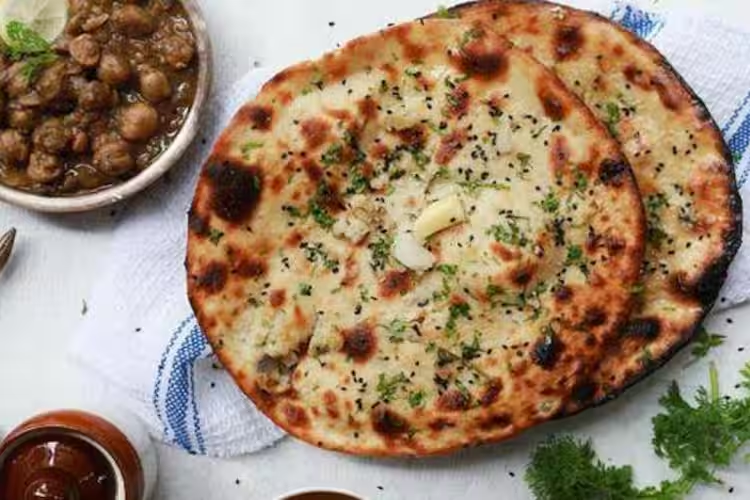Introduction to Amritsari Kulcha
This stuffed bread isn’t just breakfast — it’s a tradition, a conversation starter, and, honestly, a mood-lifter. Imagine biting into a crisp, golden crust, only to meet a fluffy, steaming interior bursting with spiced fillings. The taste lingers, the texture comforts, and the experience makes you wonder how you ever settled for plain bread. It’s the kind of food that can brighten even the dullest morning and make you feel like the day has started on a celebratory note. Many locals believe that starting the day with a Amritsari Kulcha is almost like getting a warm hug from the city itself, filling you with joy before you’ve even finished your first cup of tea.

History and Origins
The journey of Amritsari Kulcha begins in the heart of Amritsar, a city known for its deep-rooted hospitality and culinary brilliance. Originally, kulchas were a royal bread enjoyed in the Mughal courts, often paired with rich gravies and elaborate side dishes. Over time, they made their way to the streets where creativity and local flavours transformed them into something extraordinary. Amritsar’s street vendors swapped the refined courtly style for a rustic, hearty version — one loaded with spice, texture, and personality. That transformation is what gave birth to the Amritsari Kulcha we know today, a dish that proudly wears its city’s identity in every bite. It’s proof that when tradition meets innovation, magic happens, and in this case, the magic is edible.
Order Online
The Culinary Roots in Amritsar
Walk through the city early in the morning and you’ll see smoke rising from tandoors, the air heavy with the scent of fresh bread, ghee, and sizzling spices. Families and friends gather around wooden benches at roadside dhabas, patiently waiting for a plate of freshly made kulchas with chole. It’s not just food; it’s part of the city’s daily rhythm, a comforting ritual that locals have embraced for generations. Many visitors end up forming an unbreakable bond with their favourite stall owners, returning year after year just for that same taste.
Evolution of the Dish Over Time
What started as a humble potato-stuffed flatbread soon expanded into a world of fillings. Some creative cooks began experimenting with mushroom and corn fillings, while others introduced subtle twists in seasoning — a pinch of ajwain here, a squeeze of lemon there. Each generation of cooks added its signature touch, ensuring the kulcha stayed exciting without losing its authenticity. Today, it’s just as likely to be served in a fancy restaurant as it at a roadside stall, proving its versatility and timeless charm.
What Makes Amritsari Kulcha Special?
The secret lies in the dough. Unlike regular flatbreads, this dough is enriched with yoghurt and milk, making it soft and pillowy inside while still developing a crisp outer layer when cooked. Baking powder and baking soda help it puff beautifully, while resting the dough allows the flavours to develop and the texture to soften. Then there’s the stuffing — a burst of flavour tucked into every bite. The potato filling seasoned with earthy cumin, tangy coriander powder, green chilies for heat, and fresh coriander for a pop of freshness. Variations like paneer-cheese blends and mixed vegetable stuffings give you different flavours without losing that familiar charm. It’s the balance between the hearty filling and the melt-in-your-mouth bread that makes every bite so memorable.
Ingredients and Preparation
Making Amritsari Kulcha at home starts with simple pantry staples — flour, yoghurt, warm milk, a touch of sugar, salt, and leavening agents for the dough. For the stuffing, boiled potatoes mashed and seasoned generously, often with a hint of garam masala for depth. Everything kept on the drier side to avoid sogginess, ensuring that the bread cooks evenly and holds its shape. Once the dough has rested, small balls are rolled out, stuffed, and carefully sealed before being flattened again. Cooking them in a traditional clay tandoor brings a smoky depth that’s hard to replicate, but a hot cast-iron pan or Tava still delivers delicious results. As soon as they’re cooked, they’re brushed — or rather, drenched — with butter, because that’s the Amritsari way, and no one in the city would dream of skipping that step.
Traditional Serving Style
An actual Amritsari Kulcha experience is incomplete without its sidekicks. The most iconic pairing is spicy, tangy chole — chickpea curry slow-cooked with tomatoes, onions, and a masala blend that’s as secretive as it is irresistible. The combination of flavours is so perfectly in sync that you’ll find yourself wiping the plate clean with the last piece of bread. And in Amritsar, that’s not just allowed — it’s expected, almost as if the meal isn’t truly complete until your plate is spotless.
Street Food Culture of Amritsari
The streets of Amritsar dotted with kulcha shops, each with its loyal fan base. Places like Bharawan Da Dhaba and Kesar Da Dhaba have been perfecting their recipes for decades, drawing locals and tourists alike. In Amritsar, the morning kulcha-chole ritual is almost sacred — people travel across the city to eat at their favourite spot, sometimes standing in line for hours. You can hear the rhythmic clapping of dough being rolled, smell the butter melting over hot bread. And see plates being whisked away to eager customers in seconds. Every bite carries a piece of the city’s soul, making it a must-have for anyone visiting Punjab.
Nutritional Value and Health Insights Amritsari Kulcha
Yes, it’s an indulgence — made with refined flour, brushed with butter. And often served with rich curry — but you can easily make lighter versions at home. Swapping all-purpose flour for whole wheat, reducing the butter. And experimenting with oil-free cooking methods like steaming or baking can make it more health-friendly while keeping much of the flavour intact. Some home chefs even swap the potato filling for protein-rich chickpea mash or lentil blends for added nutrition. If you’re feeling creative, you can mix in flaxseeds or chia seeds into the dough for an extra boost of fibre.
Tips for Making Perfect Amritsari Kulcha at Home
The magic lies in patience and technique. Keep the stuffing dry so the bread doesn’t tear during cooking. Cook it over medium-high heat so you get that irresistible crisp exterior without burning it. And don’t skimp on butter — it’s not a kulcha without that glossy, golden finish. Even if you’re making a healthier version, a light brush of butter can work wonders for the flavour.
Common Mistakes to Avoid
One of the most common errors is overstuffing, which leads to bursting during cooking. Rolling the kulcha too thin can make it lose its fluffy texture. While skipping the dough’s resting period can result in a flat, chewy bread. Taking your time with each step is key to achieving that authentic Amritsari flavour. Also, remember not to overcook — while you want a crispy crust, the inside should remain soft and airy.
Conclusion
Every bite is a mix of crispiness, softness, spice, and comfort, telling a story of tradition, community, and culinary passion. Whether you’re enjoying it in the lively chaos of Amritsar’s streets or making it in your kitchen. One thing’s certain — once you’ve had it, it’s hard to go back to plain bread. It’s the kind of comfort food that stays with you long after the last bite. Making you crave that perfect balance of crunch and melt all over again.
FAQs
Can I make Amritsari Kulcha without a tandoor?
Yes, a heavy tava or cast-iron pan works beautifully. Giving a crispy exterior and soft interior without needing traditional clay tandoor baking.
Is Amritsari Kulcha vegan?
Traditionally, no, because it contains dairy like yoghurt and butter, but plant-based alternatives can used for an entirely vegan-friendly version.
How long can I store the dough?
You can store it up to 24 hours in the fridge. But always let it come to room temperature before cooking for best results.
What’s the best drink to pair with it?
A chilled sweet or salty lassi is the perfect partner. Balancing the buttery richness of the kulcha with refreshing creaminess in every sip.
Can I freeze cooked kulchas?
Yes, wrap them in foil, freeze for up to a month. And reheat on a hot tava before serving to maintain texture and flavour.
